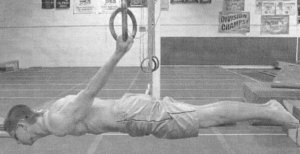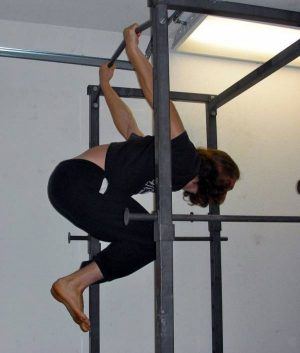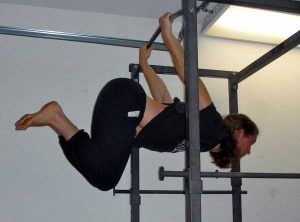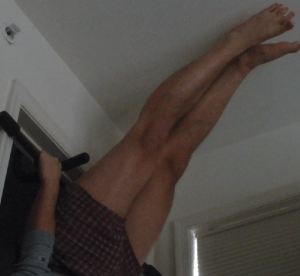If you will recall, a few months ago I wrote an article about gymnastics for the masculine man. Namely, how masculine men can utilize gymnastics to develop a great degree of strength, dexterity, and flexibility with very little space or equipment. And I still stand by that article, especially as my foot is still keeping me out of the gym until this coming April at the least. I am still capable of doing the static gymnastic poses.
But, of course, these are a daunting task to undertake for a man who is just beginning to train in gymnastics. The novice often doesn’t know where exactly to start. From my experience, the easiest fundamental gymnastic static hold to master, and the one that has the most visible signs of progress, is the back body lever.

What Is It?
The back body lever is a static pose where your arms are held above your prone body as it hangs in mid air, with your head in front and the legs extending horizontally. Much like its easier forebear “skinning the cat” (discussed below), this one also develops the strength and dexterity of the shoulder rotator, as you are essentially hanging from this anatomical feature.
As you might expect, you won’t be able to go into the full body lever right from the beginning, you have to work up to it through a series of progressively more complex exercises, the same as any other type of calisthenic.
To begin with, start with the inverted tuck hang

This isn’t me, because my pull-up bar is situated in a way that the picture would be nothing more than my ass sticking out of a door frame.
You achieve this hold by hanging from a bar, and then lifting your legs up and through the “Grapevine” you make with your arms, bringing your legs down until your knees are parallel to the floor. This motion is dubbed “skinning the cat.”
When done properly, you will feel muscular tension in your shoulders and in the muscles of the armpit. Keep the legs tucked tight, and just hold it for 10 seconds.
Once you’ve done that, you can attempt the straight back tuck hang.

See the above caption
It’s just like the inverted tuck hang, but you keep your back straight. I find that pushing down with my hands and flexing the lats, combined with actively concentrating on straightening the back, will give you the proper pose.
Doing this pose will increase the involvement of the muscles of your lower back. You will noticeably feel a greater “burn”.
Once you have mastered this, try to extend your legs down to the floor while still keeping the back straight. This involves more strength and flexibility of the lower back, and in reversing the hold begins to involve the muscles of the hip flexors and abdomen as well: when you have assumed the proper pose (that is to say, going into the straight back hang with the legs fully extended), use the muscles of the torso to roll your body upwards and bring your feet back above your head while simultaneously keeping the back straight. You can do this for repetitions for a decent abdominal workout, but we of course would like to move on.
The last step I will be teaching you today is the inverted straight hang. More specifically, a modified variation of this hold. If you have gymnastic rings, these can be simply done (note that I use the term “simply” rather than “easily,” nothing about these exercises is particularly easy) by starting the “skin the cat”, rotating only half way so that your back is vertical, and then extending the legs until your back, hips, and legs are completely vertical and straight.
Seeing as I don’t have gymnastic rings, and it’s more likely that my readers own pull-up bars or have a conveniently placed horizontal support than own a pair of gymnastic rings, I will instead teach you a slightly modified form of the inverted straight hang.
Begin in the half-inverted hang as stated above. Then extend your feet and touch the ceiling. Unless you’re really short, your hips are still about halfway bent. Begin rolling back towards the full inverted hang, but do not complete the rotation. Each inch that you rotate further, straighten your hips a little bit more and extend your legs a bit farther. A good way to judge this is to progressively lean higher and higher portions of your buttocks against the horizontal bar, eventually reaching the lumbar region of the back, as I attempted to show in this image below.

I couldn’t have you people thinking I couldn’t “walk the walk.” To answer your questions: 1) Yes, this is the best possible picture I could have taken and 2) Yes, I usually don’t wear pants at home. Deal with it.
You will be slightly angled, but your body will be straight, and that is what is important.
And from here you can begin trying to slowly lower yourself into forms of back levers, “lowering into a hold” being a concept that is of the utmost importance in gymnastics.
But that is an article for another day.
Read More: How Gymnastics Can Improve Your Total Body Fitness
“Man who make back spring on bedspring during spring break make offspring next spring” https://uploads.disquscdn.com/images/d3fd63aa39fea3c49823996e321bbb2e5a4343fdbee18b8c22057c221532cba4.jpg
After i discontinue my work-desk job fourteen months ago, I was blessed to find out about following awesome job offer that was a life saver for me… They offer jobs for which people can do their work online from their home. Last paycheck after being on this job for them for four months was 10000 dollars… Awesome thing about is that the only requirement for to get started is simple typing skills and a stable internet connection… https://www.facebook.com/Internet-Jobs-for-US-UK-Australia-Canada-and-New-Zealand-1585996635048445/app/190322544333196/
Nice. Been looking to get into this & the front lever & improving my L sit. Currently relying on Coach Christopher Sommer’s ‘Building The Gymnastic Body’ as a guide for working on these.
I use that book myself, it’s great.
Gymnastics is notorious for ripping shoulder tissues, dislocations, etc, and this particular move has a lot of force going through internally rotated humeri. What, in your, or clients’, experience is the likelihood of injury with this one? Thanks
I haven’t had any myself-I imagine that, assuming you don’t take any stupid risks (hyper-extension, etc.), you’re not any more likely to injure yourself with a static hold then you would be with just regular weightlifting.
Everything has some chance of injury. I have had a load of injuries from weightlifting.
That said, I would rather have acute injuries from exercise than the life long mental and physical injuries from being out of shape
I wouldn’t have a beginner work on this.
There are plenty of other areas to work first and the way into this particular exercise could be gently introduced by shoulder mobility drills with a stick.
I just walk seven miles a day to keep my bloodpressure down. Wake up at 2:55 AM. Say my morning prayerbook prayers and walk from about 3:15 to 5:45.to do six miles before work. Come back, send my emails/ friendly coresssponsences on SKYPE and read a little Spanish in the Bible. Try to do a chapter a day. Then listen to the chapter to reincforce.
Quite honestly, there are times when the self-discipline makes me feel strong, but at other times, it seems depressingly hard.
I do the seventh mile after work with my dog.
I do not think I would be able to do this without mp3 podcasts. As walking is boring, even when the stars are beautiful. But Armand Alducin is pretty good for Spanish language sermons, even if he is a little too Zionists for me in his extreme conservatism. Alex Jones has a good podcast. It requures littlle concentration, but it is sometimes too much to handle his screaming at 3:30 AM. . Rudolf Steiner audios are good, but require a lot of concentration.
But exercise of the body is hard unless you can also exercise the will. A full physical, mental and spiritual workout is a good thing.
Who has time for this?
This is an excellent way to tear your rotator cuff. Just had two buddies who went thru shoulder surgery doing stupid shit like this. Both are in mid-40s and pushed healthy workouts a little too far. Unless you have Joe Rogan money for stem cell injections go easy on your meat vehicle gents.
Busted my rotator cuff doing one-arm pull-ups. I was the man in the gym for a while…
Shock the body and always look for different variations of similar exercises. There are many different ways to do a push-up, a lunge and a pull-up. This looks like a cool exercise. I’m gonna try it next time I’m in the gym. FreeMotion fitness is a good product. There are endless possibilities to variations with their machines. For example; if you were to do a chest press, you can raise your target an inch at a time with each rep. Make it interesting and be creative.
Outside reading RoK, seeing Logan Christopher of legendarystrength.com pictured here made my day. If you think his back lever is impressive, look him up with a 60 kg kettlebell. And props to Mr. Halleck, for showing us all how it’s done!
This is an impressive move but looks like AC Joint would be grumpy in the morning
That’s right, although some gentler holds can have a tonic effect on the shoulder joint.
I am going to look into a book for gymnastics stuff. Any suggestions for a beginner?
PS: leaving gym now after a super volume chest and back day.
How to tell your gym is bad ass? If you are supersetting bench press and t bar row and on your 5th set of 20×20 walking from bench to t bar you puke and a stranger at a power rack randomly high fives you and between you and him a huge cloud of chalk dust goes up
Somebody mentioned Sommer’s Building The Gymnastic Body which is good as far as I remember.
However I think the book is out of print and was substituted by online courses, you may need to check that.
Low’s Overcoming Gravity is often overlooked, but interesting too.
I will see if I can torrent them. Thanks!
I have it. its pretty technical and comprehensive. Great if you are a gymnast. Personally I prefer Convict Conditioning and Dinosaur Bodyweight Training. Or The Naked Warrior.
I have it. Personally I prefer Convict Conditioning and Dinosaur Bodyweight Training. Or The Naked Warrior.
only Kratom could help at this point.
I never wear pants at home, either. Can’t get any creative work done in ’em.
Respect to the author of this article.
I do this often and it increases power and energy.